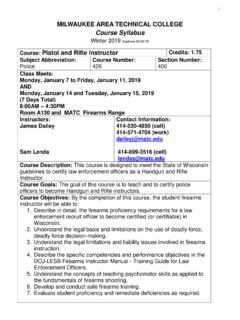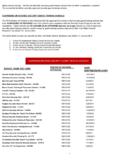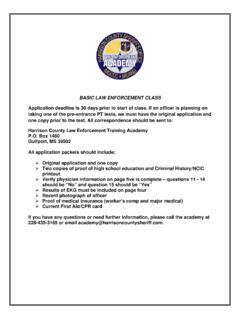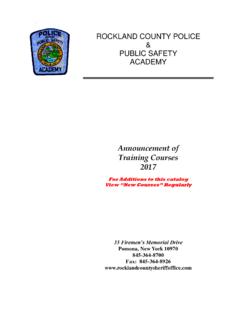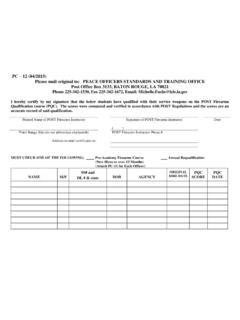Transcription of Firearms - Welcome to MATC
1 Firearms Handgun and Rifle Instructor Manual Wisconsin Department of Justice Law Enforcement Standards Board June 2016 June 2017 2 The Law Enforcement Standards Board approved this textbook on June 7, 2016. training academy effective date is January 1, 2018. All law enforcement basic preparatory training courses that begin on or after January 1st, 2018, must incorporate this updated textbook and any related updates to the curriculum. Academies beginning before that date may elect to use these updated materials. History of minor revisions: Copyright 2017 by the Department of Justice.
2 All rights reserved. June 2017 3 ACKNOWLEDGEMENTS The training and Standards Bureau, Wisconsin Department of Justice gratefully acknowledges the dedication of the Firearms training Advisory Committee, which has developed the lesson plans, videos, and exercises for use by certified Firearms instructors. The current members (and active emeritus members) of the Committee are Designated Representatives and Practitioners Mike Valencia, Sheriff s Representative Russell Jack, Chief s Representative Andrew Kleppe, Wisconsin Technical College System Kris Perales, Wisconsin State Patrol Joseph Seitz/James MacGillis, Milwaukee Police Department Dennis Konkel/Sarah Wronski, Milwaukee County Sheriff s Office Kimba Tieu, Madison Police Department Glenn Rehberg, Stephanie Pederson, training & Standards Bureau Dennis Angle, Waukesha Police Department Mark Bauman.
3 Eau Claire County Sheriff s Office Steve Harlow, Glendale Police Department Mike Jaszczak, Superior Police Department Mark Kohl, Fox Valley Technical College Raymond Merlin, Kenosha County Sheriff s Office Brian Landers, Madison Area Technical College Emeritus (non-voting) Members Randy Revling Bob Willis Darrel Bauman Kelly Rehwoldt The following people served on the Rifle subcommittee: Mark Crider, Federal Bureau of Investigation Travis Hilliard, Sauk Prairie Police Department Mike Jaszczak, Superior Police Department Bob DeFrang , Wisconsin State Patrol Kelly Rehwoldt, Dane County Sheriff s Office Joseph M.
4 Seitz/Allen Groszczyk, Milwaukee Police Department Mike Steffes, Rhinelander Police Department Brian Buckmaster, La Crosse County Sheriff s Office Kipp Hartman, Madison Police Department Tom Hamm, Kenosha Police Department Glenn Rehberg, training & Standards Bureau Special thanks to Minh Duc "Kimba" Tieu of the Madison Police Department and John Czerwinski of the Walworth County Sheriff s Office. June 2017 4 TABLE OF CONTENTS ACKNOWLEDGEMENTS .. 3 TABLE OF CONTENTS .. 4 COMPETENCIES AND LEARNING OBJECTIVES .. 6 COURSE OVERVIEW .. 9 COURSE DELIVERY.
5 9 COURSE SCHEDULE PHASE ONE (FUNDAMENTALS OF Firearms ) .. 10 COURSE SCHEDULE PHASE TWO ( Firearms AND DEADLY FORCE DECISION MAKING) .. 11 INSTRUCTOR OVERVIEW .. 13 INTRODUCTION .. 13 TEACHING TOOLS .. 16 HOW THE SYSTEM IS TAUGHT .. 17 Individual Techniques .. 17 Simulations .. 17 Intensity / Complexity 17 INSTRUCTOR NOTE: SAFE Firearms training .. 18 PHASE ONE .. 19 TOPIC 1: INTRODUCTION TO HANDGUNS .. 19 LESSON 1-1: BALLISTICS AND SAFETY .. 19 LESSON 1-2: PISTOL FUNCTION .. 24 LESSON 1-3: PISTOL MAINTENANCE .. 28 INSTRUCTOR NOTES: TEACHING SHOOTING FUNDAMENTALS.
6 33 INSTRUCTOR NOTES: SAFETY PROCEDURES FOR CLASSROOM AND LIVE-FIRE ENVIRONMENTS .. 34 Safe training Requirements .. 34 Safe training via Building-Block Approach .. 34 Safety Briefing .. 37 Triple-Search and Safety Zones .. 40 INSTRUCTOR NOTES: PLANNING AND MANAGING A FIRING RANGE .. 43 Range Safety: .. 43 Manage a Firing Range (Class Safety and Commands): .. 44 Range Commands: .. 45 TOPIC 2: SHOOTING BASICS .. 48 LESSON 2-1: FIVE FUNDAMENTALS .. 48 LESSON 2-2: THE DRAW STROKE AND READY POSITIONS .. 58 LESSON 2-3: LOADING AND UNLOADING .. 65 LESSON 2-4: CLEARING MALFUNCTIONS.
7 72 PHASE TWO .. 77 June 2017 5 TOPIC 3: LEGAL CONTEXT .. 77 LESSON 3-1: DEADLY FORCE DECISIONS .. 77 TOPIC 4: COVER, MOVEMENT AND POSITION .. 130 LESSON 4-1: USING COVER .. 130 LESSON 4-2: SHOOTING POSITIONS .. 139 LESSON 4-3: SHOOTING WHILE MOVING .. 144 TOPIC 5: SPECIAL CIRCUMSTANCES .. 151 LESSON 5-1: MULTIPLE ADVERSARIES AND CLOSE COMBAT .. 151 LESSON 5-2: SHOOTING UNSUPPORTED AND WHILE SEATED .. 155 LESSON 5-3: SHOOTING IN LOW LIGHT OR DARKNESS .. 166 LESSON 5-4: ACTIONS AFTER COMBAT SHOOTING .. 174 LESSON 5-5: REPORTING DEADLY FORCE .. 179 TOPIC 6: LAW ENFORCEMENT RIFLES.
8 185 INSTRUCTOR NOTE: TEACHING THE LAW ENFORCEMENT RIFLE .. 185 LESSON 6-1: RIFLE CHARACTERISTICS AND ADVANTAGES .. 186 LESSON 6-2: RIFLE NOMENCLATURE AND 192 LESSON 6-3: RIFLE SHOOTING FUNDAMENTALS .. 198 LESSON 6-4: SHOOTING POSITIONS .. 207 LESSON 6-5: RIFLE MALFUNCTIONS .. 217 LESSON 6-6: LOW LIGHT, CLOSE QUARTERS, AND MULTIPLE ADVERSARIES .. 224 LESSON 6-7: QUALIFICATION COURSE .. 234 TOPIC 7: UNLOADING WEAPONS OTHER THAN ONE S OWN .. 237 LESSON 7-1: OTHER HANDGUNS .. 237 LESSON 7-2: OTHER LONG GUNS .. 241 APPENDIX A: training 245 APPENDIX B: TRIPLE SEARCH PROCEDURE.
9 250 Competencies and Learning Objectives June 2017 6 COMPETENCIES AND LEARNING OBJECTIVES PHASE ONE - FUNDAMENTALS OF Firearms (16 HRS) 1. Exhibit good weapon-handling skills. Comply with general Firearms safety rules. Comply with general range safety rules. Store Firearms in a safe manner when not on duty. 2. Maintain the handgun and its associated equipment. Identify and describe the role that ballistics play in the performance of the duty handgun. Identify nomenclature and functions of semi-automatic pistols and handgun ammunition.
10 Field-strip, clean, lubricate, and function check the handgun. Maintain duty belt, holster and magazine pouches. 3. Fire the handgun proficiently. Employ the correct techniques for drawing the handgun and for recovering the handgun to the holster. Identify and perform the ready positions that an officer may employ with a drawn handgun and the uses for these positions. Load, reload, and unload the handgun. Demonstrate proficiency in basic shooting fundamentals. Identify various types of handgun malfunctions and the causes of these malfunctions.
